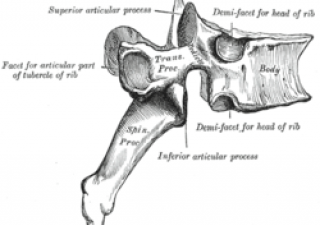Complex movements require certain anatomical allowances. Few are as important as thoracic extension.
The thoracic spine is the portion of the spine referred to as the upper back. The inherent stiffness of the thoracic spine is no evolutionary accident. It serves a purpose. Each of the thoracic vertebrae has 10 articulations, both to neighbouring vertebrae, and the attaching ribs. This large number of joints gives a clue as to the reason for the lack of mobility – rib attachments. The thoracic spine plays a major role in supporting the protective role of the ribs.
However, modern ergonomic patterns exaggerate this thoracic stiffness. Almost everything we do has a distinct ‘frontal fixation’. Working at a computer, pushing a trolley, carrying a baby, driving a car, preparing food. A common postural theme of internally rotated humerus, rounded shoulders and… yes… you guessed it… a flexed thoracic spine. If you spend enough time in this ‘frontally fixated’ position, it starts to become the norm.
Aesthetically, this causes a visible rounding of the upper back. Functionally however, the problem can be much worse. Not only can a raft of musculo-skeletal disorders result, but movement quality and efficiency (read: strength) can severely compromised. Let’s explore why.
To understand the effect of thoracic tightness on movement, I’m going to broadly categorise movement into:
- Movements below the chin (deadlift, squat and clean variations).
- Movements above the chin (press variations).
Let’s look at a movement from the first category – the squat. The squat requires two seemingly conflicting variables. First, the hips must drive back and down (as opposed to the knees breaking forwards). This ensures balance of musculature (anterior and posterior chain) around the knee. Second, the torso should remain as erect as possible. This allows a smooth segue to squat progressions; the front, back and overhead squats. These two points are difficult to achieve in partnership. One or the other is easy – both… a bit tougher. The fight to keep the chest high (ie: thoracic spine as vertical as possible) should involve not only a partial extension of the lumbar spine, but a major extension of the thoracic spine. Thoracic tightness therefore poses a problem. If the thoracic spine is tight, one of two things has to happen. Firstly, the spine is simply too tight to extend, the chest falls forward, technique falls apart, and force cannot be generated. The second thing that can happen is that the body searches desperately for a way to achieve the vertical torso you are begging of it. The thoracic spine is tight, so it looks to the next segment in the chain and hyperextends the lumbar spine. Not only is this severely compromising force production, but suddenly the discs and facets of the lower back are subject to excessive forces – and lower back injury is a logical next step. Obviously, thoracic mobility is important in this case.
Let’s address movements above the chin. Presses, push-presses, push-jerks, split-jerks, American kettlebell swings, overhead squats, snatches, pull-ups and any other overhead movement you can fathom, are all affected by the thoracic spine. Sure, they all involve a high degree of shoulder flexion to create the movement, but this on its own is not enough. They also require (you guessed it) thoracic extension. If your body can’t find enough thoracic extension, it once again looks further down the chain and ends up overextending the lumbar spine.
Not only is then once again dangerous for the lower back, but has severe performance ramification.
Athlete ‘A’ has tight shoulders. They can reach their arms overhead – but only just. Athlete ‘B’ has flexible shoulders, they can maintain an overhead position no problem. If you measured the electrical impulses in their muscles (a worthless though oft undertaken laboratory procedure) you would find that they are both equally ‘strong’ (note inverted commas). However, Athlete ‘A’ (tight overhead) is at the far corner of their length-tension curve. Their muscles are at such an extreme of length that their ability to produce tension (strength) is chronically impaired. To borrow a commonly used analogy, they have the engine of a Ferrari… but the handbrake is on. The potential is there, the brake needs to be release. Athlete ‘B’ on the other hand, is sitting right in the middle of a nice plump length-tension curve. They are able to produce maximum force because their muscles are sitting right in that physiological sweet spot.
A great way to test your own thoracic mobility is to do a wall arm lift. Try this now:
- Stand with back against wall and feet approx. 30cm from the base of the wall.
- Place one hand in the lower back and the other hand on the front of your thigh.
- Squashing the hand in your lower back, lift the other arm away from the body until it hits the wall above your head.
- Repeat with the other hand.
- Now complete with both hands, ensuring the lower back stays flat against the wall.
If you find it tough to maintain pressure on the hand in the small of your back, you have a tight thoracic spine (or weak midline stabilisers, or both). If the pressure eases, or the shoulder get tight at the top, you are unable to adequately maintain midline stability with your hands over head (let alone a max weight).





